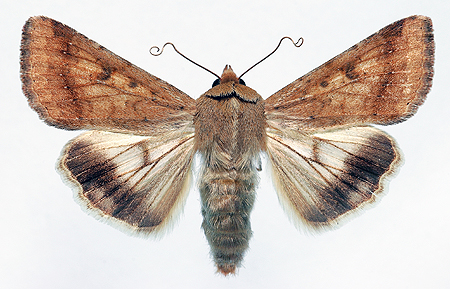Pests
Helicoverpa armigera Hbn. - Cotton Bollworm.
Systematic position.
Class Insecta, order Lepidoptera, family Noctuidae, genus Helicoverpa.Synonyms.
Heliothis armigera Hbn., Chloridea obsoleta F.Biological group.
Polyphagous pest.Morphology and biology.
Size and color of moths are variable. Body length is 12-20 mm, wing span 30-40 mm. Female forewings are orange-brown; males have lighter, greenish-gray wings. Dark band is situated between external transversal and sub-marginal lines. Transversal lines, sub-marginal line and reniform spot are diffused. Hind-wings are lighter, pale-yellow, with brown band before external edge; dark round spot is situated in the middle of wing. Imago life span is 20 to 40 days depending on temperature. Fecundity varies in the range of 500-1000 eggs, maximum to 3000 eggs. Eggs are laid one by one or in groups of 2-3 on the upper side of leaf and on reproductive organs, such as flowers, bracts, buds (cotton, chick-pea, tomatoes), on filaments of ears, panicles, and pubescent parts of stalk (maize). Development of eggs lasts 2-4 days in the summer, 4-12 days in the spring and autumn. Eggs have spherical form (0.4-0.6 mm in diameter) and costate surface; their color is white, later becoming greenish. Larvae develop over 13-22 days, reaching 35-40 mm long in the 6th instar. Larvae are greenish and yellow to red-brown. Head is yellow, with several spots; thoracic scutum has dark pattern. Three dark stripes extend along dorsal side, and one yellow light stripe is situated under spiracles on the lateral side. Ventral part of larvae is light. Pupae develop over 10-15 days in soil at depth of 4-10 cm, or in cotton bolls or maize ears. Pupae over-winter in soil pods. Pupae vary in coloration from dark-brown to red-brown; body length 15 to 20 mm.Distribution.
Species is widespread throughout tropical and subtropical regions mainly, and also in Middle and South Europe, temperate Asia, Africa, Australia, Oceania. Mass outbreaks were observed in Albania, Algeria, Bulgaria, Egypt, Spain, Portugal, Germany, Greece, Israel, Iran, Ukraine, Moldavia, Cis-Caucasia, Trans-Caucasia, Kazakhstan, Middle Asia and southern Russia. In Russia the Cotton Bollworm area occupies steppe and forest-steppe zones, reaching the southern taiga border. This is a migrant species, able to reach Scandinavia and other northern territories.Ecology.
It is a polycyclic species as follows: 2-3 generations develop in the North Caucasus, 3-4 generations in Azerbaijan and Middle Asia, 5 generations in the south of Tajikistan. The degree days for the development of one generation is 550 (at threshold 11) degrees C. Adult emergence begins at +18-20° C average daily temperature, e.g., in the middle of April in Middle Asia; in the middle of May in Azerbaijan; in the middle of June in Ukraine. Emergence lasts for more than a month. Moth flight of different generations usually overlaps and continues through October-November. Females need nectar for the beginning of oviposition. Moths are active at twilight and night. Insect development depends on temperatures and precipitation during larva nutrition, particularly in spring. Insect population depends on activity of entomophages (parasites and predators) and entomopathogens. The 1st-2nd-instar larvae feed on leaves, 3rd-6th-instar larvae feed on reproductive organs of plants. The species belongs to polyphagous insects. In Russia and adjacent countries the larvae populate more then 120 plant species; in nature they prefer Solanum sp., Datura sp., Hyoscyamus sp., Atriplex sp., Amaranthus sp.Economic significance.
The greatest damage is caused to cotton, tomatoes, maize, chick pea, alfalfa and tobacco. It is capable of causing injury to soy bean, pea, pumpkin, squash, castor-oil plant, kenaf, jute. The economic threshold of its harmfulness in Middle Asia is 3-5 larvae/100 plants on long-staple cotton and 8-12 larvae/100 plants on medium-staple cotton. Control measures include: cultivation of resistant varieties, weeding, removing crop residues from fields, deep autumn plowing, inter-row cultivation, winter watering for pupae destruction, insecticide treatments of plants during period of larva development and release of entomophages, such as Trichogramma spp. and Habrobracon hebetor Say; application of such biopreparations as Lepidocide, Virin-HA, Dendrobacillin and Bitoxibacillin. Monitoring is possible by use of sex pheromone traps.Reference citations:
Goryshin N.I. 1958. Ecological analysis of seasonal developmental cycle of the Cotton bollworm (Chloridea obsoleta F.) in its northern areas of distribution. In: Danilevskii A.S., ed. Insect ecology. Leningrad: LGU. 3-20 p. (In Russian)Komarova O.S., Kuznetsova M.S. 1969. Cotton bollworm. In: Polyakov I.Ya., Chumakov A.E., eds. Distribution of pests and diseases of agricultural cultures in the USSR in 1966. Proceedings of VIZR. Leningrad: VIZR. V. 34: 74-80. (In Russian)
Kononenko V.S. 2003. Noctuidae. In: Ler P.A., ed. Keys to the insects if the Russian Far East. V. 5(4). Trichoptera and Lepidoptera. Vladivostok: Dal.nauka. 688 p. (In Russian)
Osmolovskii G.E., Bondarenko N.V. 1980. Entomology. 2nd edition. Leningrad: Kolos. 359 p. (In Russian)
Poloskina F.M., Kuznetsova M.S. 1975. Cotton bollworm (Helicoverpa armigera Hbn.). In: Polyakov I.Ya., ed. Distribution of the main pests of agricultural crops in the USSR and efficiency of their control (Methodical instructions). Leningrad: VASKHNIL, VIZR. 58-62 p. (In Russian)
Pospelov S.M. 1989. Noctuidae - Pests of agricultural crops. Moscow: Agropromizdat. 112 p. (In Russian)
Sukhareva I.L. 1999. Noctuidae. In: Kuznetsov V.I., ed. Insects and mites - agricultural pests. V. 3, part 2. Lepidoptera. St. Petersburg: Nauka. 332-378 p. (In Russian)
Tanskii V.I. 1969. Harmfulness of the Cotton bollworm in South Tadzhikistan. Entomologicheskoe obozrenie (Leningrad), 48(1): 44-56. (In Russian)
Shchegolev V.N., Znamenskii A.V., Bei-Bienko G.Ya. 1934. Insect pests on field crops. Leningrad-Moscow: Sel.khozgiz. 364 p. (In Russian)


